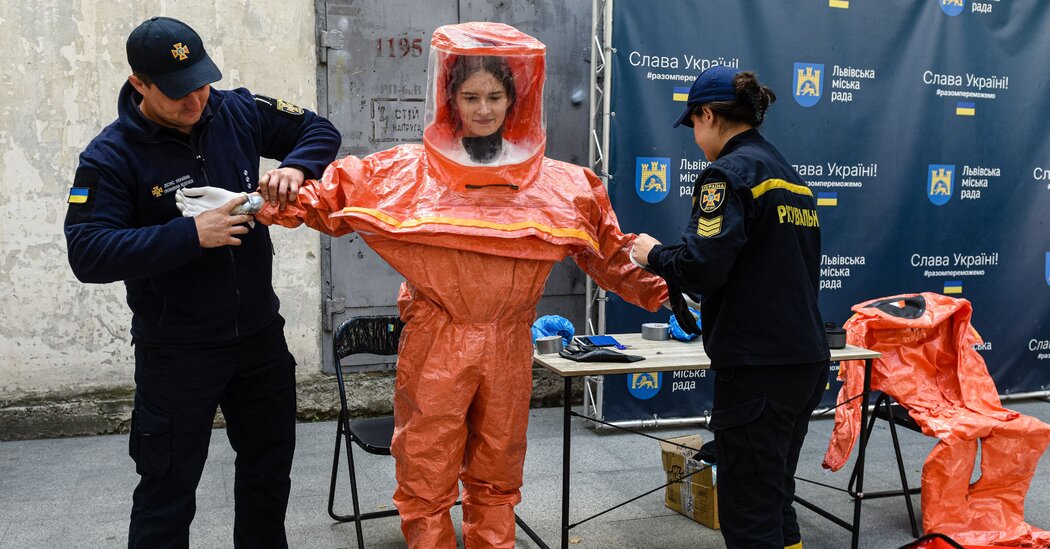
The United States is wiring Ukraine with sensors that can detect?? bursts of radiation from a nuclear weapon or a dirty bomb and can confirm the identity of the attacker.
In part, the goal is to make sure that if Russia detonates a radioactive weapon on Ukrainian soil, its atomic signature and Moscow’s culpability could be verified.
Ever since Russia invaded Ukraine 14 months ago, experts have worried about whether President Vladimir V. Putin of Russia would use nuclear arms in combat for the first time since the American bombings of Hiroshima and Nagasaki in 1945. The preparations, mentioned last month in a House hearing and detailed Wednesday by the National Nuclear Security Administration, a federal agency that is part of the Energy Department, seem to constitute the hardest evidence to date that Washington is taking concrete steps to prepare for the worst possible outcomes of the invasion of Ukraine, Europe’s second largest nation.
The Nuclear Emergency Support Team, or NEST, a shadowy unit of atomic experts run by the security agency, is working with Ukraine to deploy the radiation sensors, train personnel, monitor data and warn of deadly radiation.
In a statement sent to The New York Times in response to a reporter’s question, the agency said the network of atomic sensors was being deployed “throughout the region” and would have the ability “to characterize the size, location and effects of any nuclear explosion.” Additionally, it said the deployed sensors would deny Russia “any opportunity to use nuclear weapons in Ukraine without attribution.”
That statement goes to the fog of nuclear war and how the United States could use the new system to pierce it.
In one scenario, Washington could use information gathered by the network to rule out the possibility of misidentifying the attacker who set off a nuclear blast. That might seem like an unnecessary step given the distinctiveness of a mushroom cloud. But if a weapon was delivered by a truck, tank or boat instead of a conspicuous missile with a trackable flight path, figuring out its origins might prove near impossible.
Public knowledge of such defensive planning, nuclear experts say, can deter Moscow by letting it know that Washington can expose what is called a false-flag operation.
For instance, Moscow could falsely claim that Kyiv set off a nuclear blast on the battlefield to try to draw the West into deeper war assistance. But in theory, with the sensor network in place, Washington would be able to point to its own nuclear attribution analyses to reveal that Moscow was in fact the attacker.
Last fall, Russia, without offering any evidence, claimed repeatedly that Ukraine was planning to explode a bomb designed to spread radioactive material, a so-called dirty bomb. Washington warned that the Kremlin was trying to create a false-flag pretext to escalate the war.
The science of nuclear attribution underwent rapid development in the United States after the September 2001 terrorist attacks raised the issue of domestic nuclear terrorism. While the science has secretive aspects, its outlines are publicly known.
Now, this newly acquired capability is being used on foreign soil in the context of a potential nuclear war or a Russian attack on Ukraine’s 15 nuclear reactors at four power generation sites.
“If a nuclear emergency were to occur in Ukraine, whether a radiation release from a nuclear reactor or a nuclear weapon detonation,” the security agency said in its statement, “scientific analyses would be rapidly provided to U.S. government authorities and decision-making centers in Ukraine and the region to make actionable, technically informed decisions to protect public health and safety.”
Nuclear experts say such defensive precautions could face their greatest test in coming weeks as the Ukrainian army launches its spring offensive. China has leaned on Russia to discontinue its nuclear saber rattling and Mr. Putin has not recently invoked a nuclear threat. But Western experts worry that Russia’s battlefield failures are making Mr. Putin, if anything, more dependent on his nuclear arsenal, and they worry that fresh setbacks could increase his willingness to pull the nuclear trigger.
The security agency reports to Jennifer M. Granholm, the energy secretary. Last month she told Congress of the general precautions for radiation detection in Ukraine and said the objective of the U.S. assistance was “to make sure that the Ukrainians are safe and not exposed.” She gave few details, however, saying that would require a closed session.
The Energy Department and the security agency say they are spending roughly $160 million on the atomic precautions in Ukraine this year, with a similar amount requested for 2024.
Jeffrey T. Richelson, author of “Defusing Armageddon,” a 2009 book on the Nuclear Emergency Support Team, reported that it often teamed up with the Joint Special Operations Command, an elite military unit so secretive that the Pentagon for years refused to acknowledge its existence.
Experts say Ukraine needs all the help it can get because its nuclear infrastructure is so extensive and has faced heavy attacks by Russia over the past 14 months.
Shortly after the start of the invasion, Russian forces seized control of the defunct Chernobyl nuclear plant, which in 1986 suffered a meltdown that sent radioactive clouds over parts of Europe and locally left a wasteland of contaminated soil. The Russian troops dug up a nearby section of earth, increasing radiation levels in the area but not enough to endanger workers.
The Russian forces also fired on and captured Europe’s largest nuclear power plant, Zaporizhzhia, a complex of six reactors. A fire broke out during the assault, but safety officers detected no radiation.
A main Ukrainian site for nuclear research in Kharkiv — the sprawling Institute of Physics and Technology — suffered 100 strikes from Russian shells and missiles in the conflict’s early days. The salvos damaged a nuclear facility used for the production of medical isotopes, but experts found no radiation leaks. The overall complex lost power for more than a month.
In Kyiv, Russian projectiles hit the Institute for Nuclear Research, starting a fire in a warehouse. The institute’s small reactor was undamaged, and no radiation leaks were found.
Ukraine’s other atomic infrastructure includes additional power plants; storage sites for spent nuclear fuel; and facilities across the nation, including hospitals, that use radioactive materials for research and medical therapies.
The Energy Department, in addition to NEST’s assistance, says it is providing support to partner agencies in Ukraine on measuring aerial radiation, modeling atmospheric plumes of radiation, countering nuclear smuggling and treating radiation injuries.
Edwin Lyman, a nuclear power expert at the Union of Concerned Scientists who has closely monitored the Ukrainian war, said a federal official told him of a possible reactor threat scenario. It posits that Russia, if it suffered a humiliating defeat and withdrew from Ukraine, might retaliate by firing on a reactor or its spent fuel storage areas in order to release high radioactivity into the environment.
“That’s one of the biggest dangers,” Dr. Lyman said. “If they wanted to render as much of the countryside as they could uninhabitable, those reactors might become targets.”
He was heartened, Dr. Lyman added, to learn that NEST and the Energy Department were “being proactive and taking these threats seriously.”
The post U.S. Wires Ukraine With Radiation Sensors to Detect Nuclear Blasts appeared first on New York Times.


